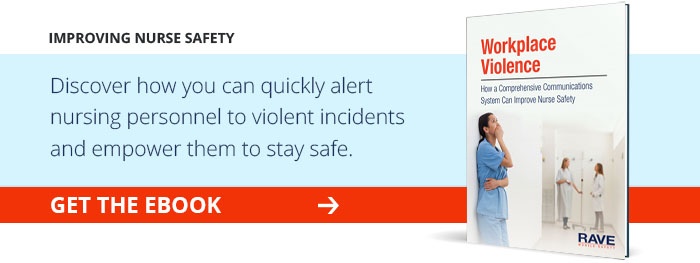Le rôle de la communication dans la sécurité des infirmières sur le lieu de travail
Communication plays an incredibly wide-ranging role in workplace safety for nurses – from ensuring there are safe levels of nurse staffing to reporting workplace violence to alerting nurses to incidents which require the activation of emergency preparedness plans. Between the two extremes, communication has many other important roles to play – but it could play more.
Nurse staffing was a challenge even before the coronavirus pandemic. The combination of an aging population, large numbers of healthcare workers reaching retirement, and fewer recruits entering the industry left staffing shortages in practically every area of healthcare. In 2018, it was forecasted that there would be a shortage of more than half a million registered nurses by 2030.
Then the COVID-19 pandemic struck and the toll on healthcare workers was immense – so much so that a pulse survey conducted in February 2021 found that 18% of registered nurses planned to quit within the next six months. If the rate of nurses planning to leave the profession is constant throughout the US, it would increase the nursing shortage by a further 684,000 almost overnight.
Workplace violence continues to be a reason for nursing staffing shortages as well. A 2016 New England Journal of Medicine published a comprehensive review of “Workplace Violence against Health Care Workers in the United States.” The review included data from the Bureau of Labor Statistics showing healthcare workers are nearly four times as likely to require time away from work as a result of violence as they are because of other types of injury. The review found 46% of nurses reported some form of workplace violence during their five most recent shifts.
Staff shortages has posed an interesting challenge in the healthcare industry. Ensuring there are safe levels of nurse staffing, accessible reporting measures for workplace violence, and adequate alert notifications to nurses during incidents that require the activation of emergency preparedness plans would better protect essential healthcare employees.
The Consequences of Filling Staff Shortages Too Quickly in Emergencies
While filling staff shortages with trained nurses from the existing workforce should not create issues with responding to emergencies, personnel who have not had the time to learn emergency protocols – or those for whom English is not their first language – might struggle to understand the many different types of emergency notifications in healthcare facilities or know how to respond.
In most circumstances, nurses – despite any inexperience – are well prepared to respond to incoming medical emergencies. However, personnel who have been fast-tracked into nursing roles may have only been taught the basics of emergency procedures to comply with CMS’ Emergency Preparedness Requirements for training when events such as fires, active assailants, and cyberattacks occur.
With so much information to absorb in a short space of time, it is conceivable nurses may forget or confuse the appropriate response to each type of emergency. A personal safety app for healthcare personnel can help overcome scenarios in which an emergency response is hindered by inexperience or panic by providing a repository of procedures and protocols relevant to each nurse’s role.
Personal safety apps have capabilities that can help enhance workplace safety for nurses in other scenarios. For example, apps can be configured with panic buttons that alert security to attacks on nurses; they can be used as safety timers for traveling nurses, and they can also auto-translate emergency alerts and non-emergency notifications for nurses whose first language is not English.
Healthcare organizations can address short-term shortages is with nurse polling. This SMS communication solution allows nurse managers to poll nursing personnel about their availability to fill shift vacancies.
Using Mass Communications to Support a Return to the New Normal
During the coronavirus pandemic, one of the ways in which healthcare organizations have been covering staff shortages is to reassign personnel from other departments. In many cases this resulted in the postponement of non-elective surgeries and limited outpatient services. As the vaccination program moves forward, and hospitalizations lessen, these services are resuming.
However, the ways in which these services function and patients are managed may be a lot different than previously to comply with social distancing and sanitation protocols. Indeed, in some circumstances completely new organizational procedures may have to be introduced to mitigate the ongoing threat of coronavirus if vaccines prove to be ineffective against new strains of the virus.
Notifying staff and patients of new procedures could be a logistical nightmare – especially if different procedures are introduced for staff and patients who have been vaccinated and for those who have not, or if nurses are returning to work following a long absence. However, a solution to support a return to the new normal in a potentially fluid situation is mass SMS notifications.
Mass SMS notifications have the advantage over other types of communication solutions in as much as they have SMS opt-in capabilities. This means healthcare organizations can use existing personnel contact databases to inform staff of new procedures, while patients visiting a hospital for treatment can opt into the service to receive details of procedures relevant to their visit.
Addressing the Unspoken Elephant in the Room
One of the biggest threats to workplace safety for nurses is workplace violence. Rave’s 2021 Workplace Safety and Preparedness Survey found that, in the healthcare industry, almost a third of respondents claimed their employers consider workplace safety and employee health to be of little or no importance.
Unfortunately, nobody knows how big a threat workplace violence in healthcare is due to significant underreporting. For example, in one survey, only 12% of informally reported incidents of workplace violence were documented – despite an HR policy mandating the documentation of all reports.
However, the underreporting of workplace violence in healthcare is not solely attributable to nurse managers failing to document reports. A 2015 report published by OSHA suggests there are multiple reasons for the failure to report workplace violence in healthcare, including:
- The perception that violence is “part of the job”.
- The fear of retaliation (when reporting a co-worker).
- A lack of training in violence prevention.
- The lack of a reporting system – or lack of faith in the reporting system.
- The lack of effective means of emergency communication.
The issue with the underreporting of workplace violence is that, until the scale of the problem is understood, healthcare organizations are unable to address it. Yet healthcare organizations should be motivated to establish the scale of workplace violence and address the unspoken elephant in the room because 21% of nurses are planning to leave the profession because of it – more than are planning to quit their jobs because of coronavirus burnout and other COVID-related reasons.
So, how can healthcare organizations get around the perception that violence is part of the job, the fear of retaliation, or the lack of faith in a reporting system? The answer is for healthcare organizations to educate nurses on the value of reporting incidents of violence (i.e., if we don´t know, we can´t do anything about it) and then implement a mechanism that empowers nurses to feel confident about reporting workplace violence – preferably a mechanism they are familiar with.
Establishing the Scale of Workplace Violence with Nurse Polling
Previously it was discussed how nurse polling could be used to address short-term staff shortages. To further expand on this use, when a shift vacancy occurs, nurse managers send a text message to all suitable personnel soliciting their availability to cover the shift. The poll usually has a Q&A format that recipients answer by pressing a number on the keypad of their mobile device:
Q: Looking to cover two early RN shifts in the Oncology Unit. Are you available?
A1: Yes
A2: No
The poll Q&A format can be extended to cover multiple answers, and the format can be applied to multiple use cases. For example, during an emergency, incident commanders can send a poll to establish the wellbeing of personnel who may be caught up in the event.
The initial poll can be followed up with automatic secondary polls depending on the answer to the first question. For example, a person replying they need medical help might then be asked about the nature of their injuries, whether they have suffered a loss of blood, or if they are with other people.
In the context of establishing the scale of workplace violence in healthcare, nurse poll Q&As could be sent daily and extended to the point where the nature, the location, and the perpetrator of a violent act is recorded on the polling platform so healthcare organizations can clearly identify where action needs to be taken to enhance workplace safety for nurses. An example of how this might work is:
Q1: Were you a victim of workplace violence yesterday?
A1: No.
A2: No, but I saw a colleague being victimized.
A3: Yes. I was the victim of physical abuse.
A4: Yes. I was the victim of sexual abuse.
A5: Yes. I was the victim of verbal abuse.
A6: Yes. I was the victim of psychological abuse.
A7: Yes. I was the victim of another type of abuse.
The initial questions can vary according to type of healthcare facility and previously identified types of abuse. For example, a healthcare organization that has received reports of discriminatory, retaliatory, or online abuse may wish to record the prevalence of each type separately. However, subsequent questions should seek to establish the nature, location, and perpetrator of each violent act. Therefore, if a nurse has reported he or she was the victim of physical abuse in the first question by pressing #3 on their keypad, subsequent questions could be:
Q2: How where you physically abused? (pushed, slapped, spat at, kicked, strangled, etc.)
Q3: Where did the violent act take place? (Location 1, location 2, location 3, etc.)
Q4: Who perpetrated the attack? (Patient, visitor, colleague, unknown, etc.)
Q5: Do you wish to make a formal report? (Yes – with link to report webpage / No – with reminder of the value of reporting incidents of violence)
To make it easier for healthcare organizations to establish the scale of workplace violence, all of the initial and subsequent questions and answers can be set up in advance using templates. The polling platform can be configured to send the subsequent questions and answers automatically depending on responses to the previous polling message, and all the responses are recorded on the polling platform for review. It is also possible to identify personnel who have not responded to the Q&As.
Find Out More about Using Communication to Enhance Workplace Safety for Nurses
An SMS messaging platform can help healthcare organizations fill shift vacancies quickly and effectively, support emergency preparedness planning, contribute towards a return to the new normal, and establish the scale of workplace violence in healthcare so action can be taken to address threats to workplace safety for nurses.
If you would like to find out more about these and other ways in which the power of SMS messaging can be leveraged to provide a safer working environment for nurses, do not hesitate to get in touch. Our team of communication safety experts will be happy to organize a demo of the Rave platform tailored to your specific requirements.





